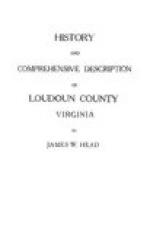[Footnote 1: “Piedmont” means “foot of the mountain.” “Piedmont Virginia,” with a length of 250 miles and an average width of about 25 miles, and varying in altitude from 300 to 1,200 feet, lies just east of the Blue Ridge Mountains, and comprises the counties of Loudoun, Fauquier, Culpeper, Rappahannock, Madison, Greene, Orange, Albemarle, Nelson, Amherst, Bedford, Franklin, Henry, and Patrick. It is a portion of the belt that begins in New England and stretches thence southward to Georgia and Alabama.]
The particular geographic location of Loudoun has been most accurately reckoned by Yardley Taylor, who in 1853 made a governmental survey of the county. He placed it “between the latitudes of 38 deg. 52-1/2” and 39 deg. 21” north latitude, making 28-1/2” of latitude, or 33 statute miles, and between 20” and 53-1/2” of longitude west from Washington, being 33-1/2” of longitude, or very near 35 statute miles.”
Loudoun was originally a part of the six million acres which, in 1661, were granted by Charles II, King of England, to Lord Hopton, Earl of St. Albans, Lord Culpeper, Lord Berkeley, Sir William Morton, Sir Dudley Wyatt, and Thomas Culpeper. All the territory lying between the Rappahannock and Potomac rivers to their sources was included in this grant, afterwards known as the “Fairfax Patent,” and still later as the “Northern Neck of Virginia.”
“The only conditions attached to the conveyance of this domain, the equivalent of a principality, were that one-fifth of all the gold and one-tenth of all the silver discovered within its limits should be reserved for the royal use, and that a nominal rent of a few pounds sterling should be paid into the treasury at Jamestown each year. In 1669 the letters patent were surrendered by the existing holders and in their stead new ones were issued.... The terms of these letters required that the whole area included in this magnificent gift should be planted and inhabited by the end of twenty-one years, but in 1688 this provision was revoked by the King as imposing an impracticable condition."[2]
[Footnote 2: Bruce’s Economic History of Virginia.]
The patentees, some years afterward, sold the grant to the second Lord Culpeper, to whom it was confirmed by letters patent of King James II, in 1688. From Culpeper the rights and privileges conferred by the original grant descended through his daughter, Catherine, to her son, Lord Thomas Fairfax, Baron of Cameron—a princely heritage for a young man of 20 years.
BOUNDARIES.
The original boundaries of Loudoun County were changed by the following act of the General Assembly, passed January 3, 1798, and entitled “An Act for adding part of the county of Loudoun to the county of Fairfax, and altering the place of holding courts in Fairfax County.”




